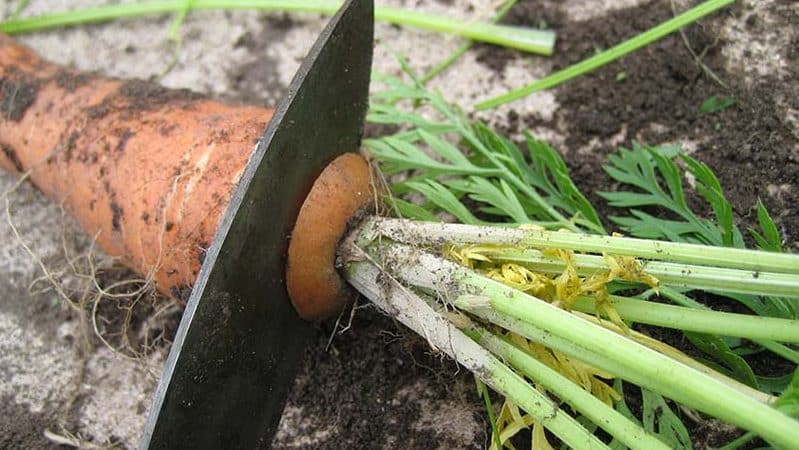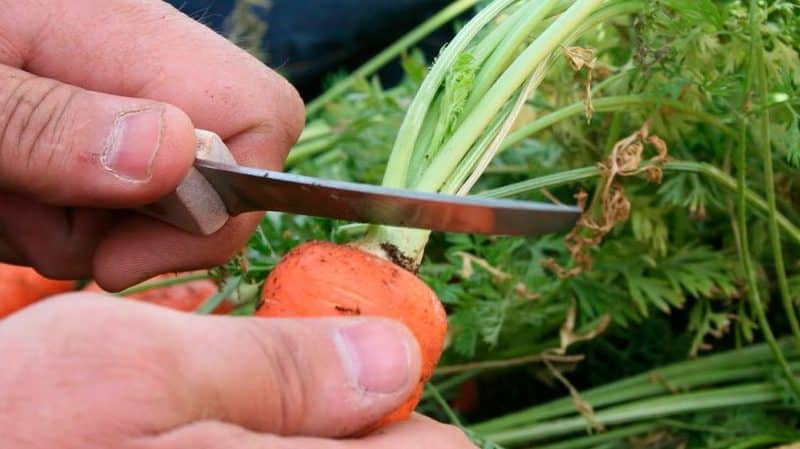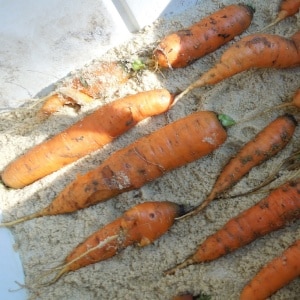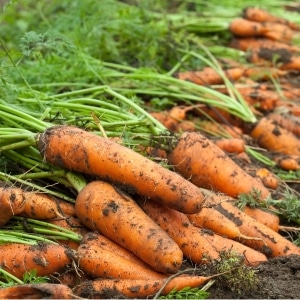Preserving the harvest correctly: how to trim carrots for winter storage and why this is necessary
Often the reason for the rapid deterioration of root crops in storage, withering and loss of presentation is a violation of the conditions storage. Sometimes this happens due to non-compliance with the rules for preparing carrots for storage.
In this article we will tell you whether it is necessary to cut off the tops of carrots before storing them for the winter and, if so, how to do it correctly.
Why trim carrots before storing them for the winter?
Trimming carrots – procedure for removing tops from a vegetable.
How does trimming the tops before storing them for the winter affect the safety of carrots:
- extends shelf life;
- retains useful elements in vegetables;
- stops decay processes;
- prevents carrots from drying out;
- stops root growth.
Is it necessary to do this?
Is it necessary to prune if the farmer plans to store the vegetable for only a couple of months? It is imperative to remove carrot tops! If you leave the green mass, it will soon begin to actively grow, absorb water and beneficial microelements from the root crop. To prevent the wilting process and keep the vegetable juicy, the tops are trimmed, but this is done in a timely and correct manner.
Important! You cannot trim the tops while the carrots are growing in the garden. If you do this, the roots will begin to wither or rot.
How to properly trim carrots for winter storage
The pruning procedure is carried out on the day the vegetable is harvested. Before starting, the carrots are peeled and dried. The shelf life and quality of the root crop depend on compliance with pruning rules.
Important! To avoid damaging the vegetable, twisting and tearing off the tops is not recommended.
Step-by-step instruction

The procedure for cutting carrot tops:
- Dig up the root crop.
- Clear of soil and plant debris.
- If the soil is wet, wash the vegetable.
- Dry at a temperature of 15-20°C in a ventilated place for several hours.
- Take a sharp knife and cut off the blunt end of the carrot along with the tops, retreating 5-8 mm from the edge.
- Treat the cut edge with chalk to prevent rotting.
- After cutting, dry the fresh cut for several hours.
- Place in a pre-prepared place.
What other preparation is needed?
Preparation for the winter period begins before sowing. When choosing varieties pay attention to the growing season of the vegetable. Usually, varieties have better keeping quality with late ripening.
A month before harvesting, when the vegetable has already finished forming, stop watering. If this is not done, there is a high probability of infection with putrefactive diseases.
To prevent diseases, root vegetables are treated with a solution of potassium permanganate.
Before storage, the basement or cellar is prepared:
- clean, wash;
- ventilate;
- disinfected - with tobacco decoction (500 g per 20 liters of water), potassium permanganate, sulfur bombs.
How to store prepared carrots

Carrots are a demanding vegetable when it comes to storage conditions. It is susceptible to mechanical damage and does not retain moisture well. Root crops quickly wither and germinate even with a slight increase in temperature in the storage area.
Vegetable storage conditions:
- optimal room temperature: 1-2°C;
- high humidity level: not less than 90%;
- good ventilation, but without drafts;
The carrots should not show signs of damage or disease.
Difficulties may arise during storage: the vegetable begins to rot and lose its taste - this leads to loss of weight and presentation. To prevent this from happening, in winter they monitor the vegetable:
- check the humidity level in the room;
- maintain a constant temperature;
- regularly ventilate the room;
- Root crops are regularly inspected and spoiled specimens are discarded.
Best ways
After thorough drying and preparation, the root vegetables are sent for storage.
Saving methods:

- In sand. A layer of sand is poured onto the bottom of any container, then a layer of carrots is placed, then sand again, and so on, alternating layers until the container is full. In this case, the carrots should not touch each other.
- In bags. Root vegetables are placed in a bag. Sawdust, pine needles or onion peels are placed on top in a layer of 10 cm - the top layer serves as a humidity regulator in the bag.
- In wooden boxes. Carrots are placed in a container, completely filling the space. The box must be ventilated. It is not recommended to place it on the floor or close to a wall.
- In plastic bags. Up to 5 kg of carrots are placed in one bag. The packages are placed on shelves or in any container.
- In bulk. Root vegetables are placed on a wooden floor in a pyramid up to 2 m high. This storage method requires powerful ventilation in the room.
- In a refrigerator. Root vegetables are placed in the compartment for vegetables and fruits.
Shelf life
The shelf life and subsequent use depend on the cutting height of the tops:
- The carrots are cut 2 cm above the head. Shelf life – up to three months. These carrots are harvested to obtain seed material.
- Carrots are cut at a height of 5-8 mm from the head. Shelf life – up to 6 months in winter.
- The carrots are cut to 2-3 cm along with the head. Long shelf life of root crops – up to 10-12 months.
The speed of germination depends on the cutting height of the vegetable. When the tops are deeply removed, the processes stop, which means that the carrots remain juicy and retain all their beneficial and tasteful qualities.
The final shelf life depends on the technology chosen:
- moistened sand – 7-8 months;
- wooden containers without filler – 4-7 months;
- plastic bags – 3-6 months.
The condition of the tops plays a decisive role during storage. The larger the size of the stump left, the faster the growth process will begin.
Tips on the topic
How to preserve carrots for a long time:
- at the harvesting stage, discard damaged and diseased carrots;

- observe harvesting deadlines - only ripened carrots are designed for long-term storage;
- when digging up root vegetables, carefully clean them, but it is not recommended to shake or knock the carrots too much - this will lead to the formation of microcracks;
- After circumcision, wait a while - let the cut dry and crust over;
- prepare the room before storage - it should be dry and cool;
- if in winter there is a possibility of vegetables freezing, wrap the container with warm material;
- do not allow direct sunlight into the room where the vegetables are located;
- use small root vegetables first - larger ones have a longer shelf life;
- Do not store carrots close to apples - fruits emit ethylene, which causes spoilage of root vegetables.
Conclusion
For long-term preservation of carrots, the conditions for preparing the vegetable and the room are observed. Trimming the tops is a mandatory stage in preparing carrots for storage - the keeping quality of the vegetable depends on this stage.This procedure stops the growth process, preserves the beneficial substances and taste of the root crop.